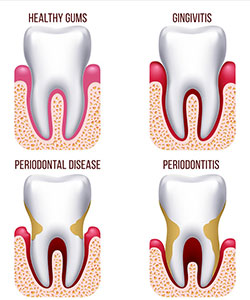Gum Disease

Gum disease, also known as periodontal disease, is a bacterial infection of the periodontium- which is made of the structures that support your teeth (gum and bone tissues). The cause of gum disease is calculus build up, plaque biofilm, bacteria, and your body's response to an infection.
Gum disease is one of the top reasons for tooth loss in adults. Many patients do not know they have the disease because it is virtually pain free. During each check up, your hygienist and Dr. Wollschlager will check for signs of periodontal disease by measuring the space between your teeth and gums, or the pockets. Based on the pocket depths, Dr. Wollschlager and his hygienist will create a treatment plan to treat the disease process in order to maintain a healthy mouth.
There are 2 stages of gum disease: Gingivitis and Periodontitis
1. Gingivitis
The early stage of gum disease. This is when the gums become inflamed, red, and bleed easily. This is usually a response to an external stimulus (plaque, hormones, etc). Gingivitis is reversible and can be treated with a debridement and proper home care.
2. Periodontitis (periodontal disease)
If not treated, gingivitis will progress to periodontitis. Periodontitis is a treatable & controllable disease- not a curable disease. The infection has now infiltrated the supporting stuctures (the gum and bone tissue). Bone loss is an irreversible process that eventually leads to tooth mobility and tooth loss. Periodontal disease can be further classified into mild, moderate, and severe (also known as Stage I, II, III, or IV).
Gum disease is diganosed based on many factors, including:
- Pocket depths (the space between the tooth and gum tissue)
- Gum recession
- Bone levels on x-rays
- Inflammation and bleeding
- Life style factors
- Medical conditions and medications
- Your oral home care routine and habits
Symptoms of gum disease:
- Gums that bleed easily
- Red, swollen, tender gums
- Gums that have pulled away from the teeth
- Persistent bad breath or bad taste
- Puss between your teeth and gums
- Loose teeth
- Changes in the way your teeth fit together when you bite
- Changes in the fit of your removable appliances
Factors that increase the likelihood of gum disease to develop:
- Smoking, using e-cigarettes, or chewing tobacco
- Diabetes
- Certain types of medication such as steroids, anti-epilepsy drugs, cancer therapy drugs, calcium channel blockers, and oral contraceptives
- Bridges that no longer fit properly
- Crooked teeth (hard to keep clean with brushing and flossing)
- Pregnancy and hormones
Treating Gum Disease
Treatments for gum disease can vary depending on the severity of each individual case. Typical treatments include:
- Non-surgical scaling and root planing (deep cleaning)
- Locally applied antibiotic therapy (Arestin)
- Medicated, at-home Perio Protect Trays
- Periodontal surgery
- Laser gum surgery